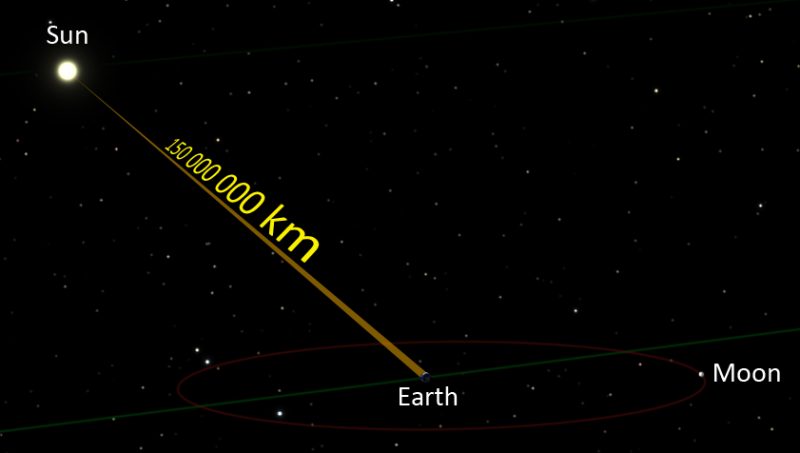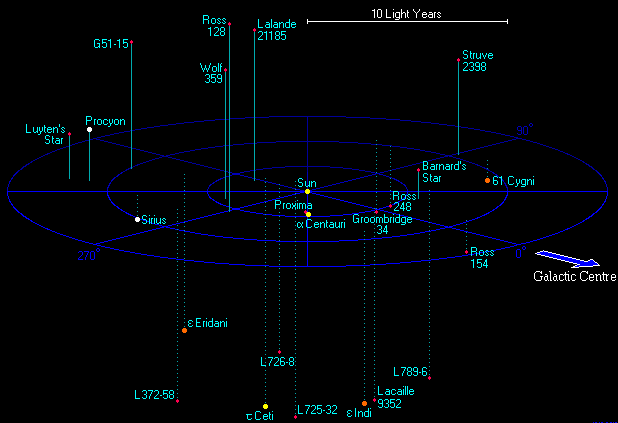| Topic: how far is a light year? | |
|---|---|
|
http://earthsky.org/astronomy-essentials/how-far-is-a-light-year
Stars other than our sun are so far distant that astronomers speak of their distances not in terms of kilometers or miles – but in light-years. Light is the fastest-moving stuff in the universe. If we simply express light-years as miles and kilometers, we end up with impossibly huge numbers. But the 20th century astronomer Robert Burnham Jr. – author of Burnham’s Celestial Handbook – devised an ingenious way to portray the distance of one light-year and ultimately of expressing the distance scale of the universe, in understandable terms. He did this by relating the light-year to the Astronomical Unit – the Earth-sun distance. One Astronomical Unit, or AU, equals about 93 million miles (150 million km). Another way of looking at it: the Astronomical Unit is a bit more than 8 light-minutes in distance.  Robert Burnham noticed that, quite by coincidence, the number of astronomical units in one light-year and the number of inches in one mile are virtually the same. For general reference, there are 63,000 astronomical units in one light-year, and 63,000 inches (160,000 cm) in one mile (1.6 km). This wonderful coincidence enables us to bring the light-year down to Earth. If we scale the astronomical unit – the Earth-sun distance – at one inch, then the light-year on this scale represents one mile (1.6 km). The closest star to Earth, other than the sun, is Alpha Centauri at some 4.4 light-years away. Scaling the Earth-sun distance at one inch places this star at 4.4 miles (7 km) distant.  he red star in the center of this picture is Proxima Centauri, our sun's nearest neighbor among the stars. A beam of light from this star takes about 4 years to travel to Earth. Image via hyperphysics.phy-astr.gsu.edu Scaling the Astronomical Unit at one inch (2.5 cm), here are distances to various bright stars, star clusters and galaxies: Alpha Centauri: 4 miles (6.4 km) Sirius: 9 miles (14.5 km) Vega: 25 miles (40 km) Fomalhaut: 25 miles (40 km) Arcturus: 37 miles (60 km) Antares: 600 miles (966 km) Pleiades open star cluster: 440 miles (708 km) Hercules globular star cluster (M13): 24,000 miles (38,600 km) Center of Milky Way galaxy: 27,000 miles (43,500 km) Great Andromeda galaxy (M31): 2,300,000 miles (3,700,000 km) Whirlpool galaxy (M51): 37,000,000 miles (60,000,000 km) Sombrero galaxy (M104): 65,000,000 miles (105,000,000 km)  There are 33 stars within 12.5 light years of our sun. Image via Atlas of the Universe. Light is the fastest-moving stuff in the universe. It travels at an incredible 186,000 miles (300,000 km) per second. That’s very fast. If you could travel at the speed of light, you would be able to circle the Earth’s equator about 7.5 times in just one second! A light-second is the distance light travels in one second, or 7.5 times the distance around Earth’s equator. A light-year is the distance light travels in one year. How far is that? Multiply the number of seconds in one year by the number of miles or kilometers that light travels in one second, and there you have it: one light-year. It’s about 5.88 trillion miles (9.5 trillion km).  This scale starts close to home but takes us all the way out to the Andromeda Galaxy, the most distant object most people can see with the unaided eye. Image via Bob King / Skyandtelescope.com. |
|
|
|
|
|
Food for thought...Thank you for sharing.
|
|
|
|
|
|
Food for thought...Thank you for sharing. i posted this because a lot of people can't really understand just how big the universe is... |
|
|
|
|
|
The distance is all the way to the end...
|
|
|
|
|
|
Topic: how far is a light year?
Uh . . . as far as the nearest ToysRUs store?  
|
|
|
|
|
|
Topic: how far is a light year? Uh . . . as far as the nearest ToysRUs store?   some triva for ya..Buzz Lightyear was originally called "Lunar Larry", his name then became "Tempus from Morph" before the name Buzz Lightyear was settled on, named after astronaut Buzz Aldrin... |
|
|
|
|
|
Mind numbing stuff and always fascinating.
|
|
|
|
|
|
I think it's far enough
|
|
|
|
|
|
That's one road trip I would not like to take with small children.

|
|
|
|
|
|
There are people that feel threatened by their insignificance to the cosmos.
Others feel a sense of wonder at the magnitude of it all. Its difficult to grasp the significance because we are limited by our own imaginations to what we experience. To us 100 years is a long time. 14 billion years IS a long time but it is mind numbing to think about it. 100 miles is a long way to walk. It is difficult for some to even fathom the distance to the moon and it is right on top of us. 100 mph is pretty fast. 17,500 mph is the speed of most asteroids. 186,000 miles per SECOND is how fast light moves in a vacuum. A 5 mile diameter comet took out the dinosaurs. Ceres is 583 miles in diameter. If you place a 5 mile object on a map of the earth and zoom out until you see the entire planet as a ball, YOU CAN"T DETECT IT. Its all scale and relativity. Reality doesn't care what your scale is. |
|
|
|
|
|
The distance is all the way to the end... Is there really an end? I took several Astronomy classes in college and I was under the impression that the Universe is infinite, in other words there is no end to it. Well, at least there is no way to prove how big the Universe really is. Think about it, does the Universe just stop somewhere? And if it does, what is beyond the end of it? Just some food for thought. |
|
|
|
|
|
The distance is all the way to the end... Is there really an end? I took several Astronomy classes in college and I was under the impression that the Universe is infinite, in other words there is no end to it. Well, at least there is no way to prove how big the Universe really is. Think about it, does the Universe just stop somewhere? And if it does, what is beyond the end of it? Just some food for thought. Just watch "the men in black" movies... At the end of the universe is a glass shell, we live in a marble... 
|
|
|
|
|
|
The distance is all the way to the end... Is there really an end? I took several Astronomy classes in college and I was under the impression that the Universe is infinite, in other words there is no end to it. Well, at least there is no way to prove how big the Universe really is. Think about it, does the Universe just stop somewhere? And if it does, what is beyond the end of it? Just some food for thought. |
|
|
|
|
|
The distance is all the way to the end... Is there really an end? I took several Astronomy classes in college and I was under the impression that the Universe is infinite, in other words there is no end to it. Well, at least there is no way to prove how big the Universe really is. Think about it, does the Universe just stop somewhere? And if it does, what is beyond the end of it? Just some food for thought. 
|
|
|
|
|
|
The distance is all the way to the end... Is there really an end? I took several Astronomy classes in college and I was under the impression that the Universe is infinite, in other words there is no end to it. Well, at least there is no way to prove how big the Universe really is. Think about it, does the Universe just stop somewhere? And if it does, what is beyond the end of it? Just some food for thought.  |
|
|
|
|
|
http://www.setterfield.org/Data_and_Creation/ZPE-Plasma_model.html#dating
Food for thought, about mid way down the box depictinglab results in how the plasma fields react, and the results from A L Perratt's testing and paper he can calculate, with the results from ZPE and orginal speed of light , what happened on what day and also the results explain how planets get thier make up, how water could have been on Mars but since there is little to no atmosphere its all evaporated among other neat scientific explainations other than we evolved from some slime, or they keep dating rocks by fossils orcdating fossils by rocks. Gotta love circular logic of the evolutionists who started thier baseless diatribe back in early 1800's. |
|
|
|
|
|
i think every one is looking at mars all wrong... i don't think mars ever could have supported life, just too cold there... venus would be the most logical place for life to have started, just for the fact the sun was much cooler back then... to bad the 700 degree temp makes it hard to explore... mars might be the next place to live, when the sun warms up more..
|
|
|
|
|
|
Did you know that Mars can get up to around 80 deg F in the heat of a summer day? The Sun is not the only form of heat a planet gets. At one time, Mars had a magnetosphere. It had a molten core. It had an atmosphere. It had internal heat sources and volcanic activity.
The Earth and Mars are roughly the same ages (around 4.5 Billion Years). Over time, Mars lost its molten core spinning inside it. The Earth was also losing its molten core until it was impacted by Theia which we now see as the Moon that regenerated the Earths molten core and spin, strengthening our magnetosphere. Mars did not receive such an impact. Over time its core slowed and cooled. Without its magnetosphere, Solar wind and CMEs blew away most of its atmosphere. With less density of atmosphere, surface pressure decreased interrupting the water cycle that helped maintain the internal heat. The Goldilocks duration of Mars was much shorter than the Earth. Any life that may have formed on Mars didn't have enough time to diversify or populate significantly. Live on Earth is roughly 3 Billion years old while Mars life may have only been 100 Million years in duration if that. Life on Earth started out as anaerobic. Its exhaling of oxygen contributed to the formation of rust and gave rise to aerobic organisms. Anaerobic life still exists on Earth in underground pockets and areas of little or no oxygen. As far as I know, the most advanced forms of them are found at black smokers deep in the oceans. Mars may have been populated by anaerobic life. That life never had time to saturate Mars atmosphere to give rise to aerobic life. That is why it is prudent for NASA to dig for samples. It is possible that anaerobic life still exists deep under Mars surface. |
|
|
|
|
|
Did you know that Mars can get up to around 80 deg F in the heat of a summer day? The Sun is not the only form of heat a planet gets. At one time, Mars had a magnetosphere. It had a molten core. It had an atmosphere. It had internal heat sources and volcanic activity. The Earth and Mars are roughly the same ages (around 4.5 Billion Years). Over time, Mars lost its molten core spinning inside it. The Earth was also losing its molten core until it was impacted by Theia which we now see as the Moon that regenerated the Earths molten core and spin, strengthening our magnetosphere. Mars did not receive such an impact. Over time its core slowed and cooled. Without its magnetosphere, Solar wind and CMEs blew away most of its atmosphere. With less density of atmosphere, surface pressure decreased interrupting the water cycle that helped maintain the internal heat. The Goldilocks duration of Mars was much shorter than the Earth. Any life that may have formed on Mars didn't have enough time to diversify or populate significantly. Live on Earth is roughly 3 Billion years old while Mars life may have only been 100 Million years in duration if that. Life on Earth started out as anaerobic. Its exhaling of oxygen contributed to the formation of rust and gave rise to aerobic organisms. Anaerobic life still exists on Earth in underground pockets and areas of little or no oxygen. As far as I know, the most advanced forms of them are found at black smokers deep in the oceans. Mars may have been populated by anaerobic life. That life never had time to saturate Mars atmosphere to give rise to aerobic life. That is why it is prudent for NASA to dig for samples. It is possible that anaerobic life still exists deep under Mars surface. true, just my personal opinion...i think life would have started on venus first, then to earth and mars... but i think mars is just to small to support any serious life as well... |
|
|
|
|
|
till the end of looking
|
|
|
|
|
















